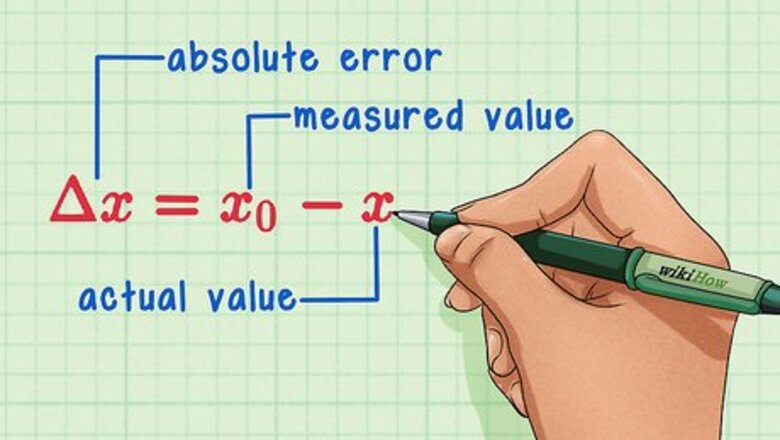
views
X
Research source
It is one way to consider error when measuring the accuracy of values. If you know the actual and measured values, calculating the absolute error is a simple matter of subtraction. Sometimes, however, you may be missing the actual value, in which case you should use the maximum possible error as the absolute error.[2]
X
Research source
If you know the actual value and the relative error, you can work backwards to find the absolute error.
Using the Actual Value and Measured Value

Set up the formula for calculating the absolute error. The formula is Δ x = x 0 − x {\displaystyle \Delta x=x_{0}-x} \Delta x=x_{{0}}-x, where Δ x {\displaystyle \Delta x} \Delta x equals the absolute error (the difference, or change, in the measured and actual value), x 0 {\displaystyle x_{0}} x_{{0}} equals the measured value, and x {\displaystyle x} x equals the actual value.
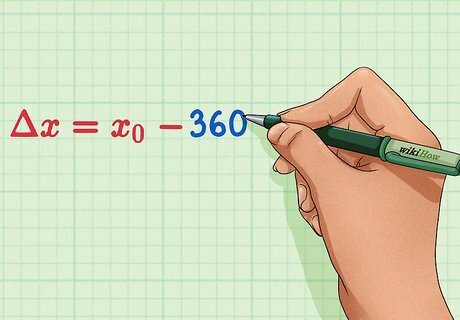
Plug the actual value into the formula. The actual value should be given to you. If not, use a standardly accepted value. Substitute this value for x {\displaystyle x} x. For example, you might be measuring the length of a football field. You know that the actual, or accepted length of a professional American football field is 360 feet (including both end zones). So, you would use 360 as the actual value: Δ x = x 0 − 360 {\displaystyle \Delta x=x_{0}-360} \Delta x=x_{{0}}-360.
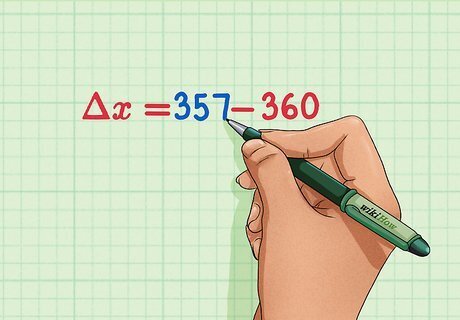
Find the measured value. This will be given to you, or you should make the measurement yourself. Substitute this value for x 0 {\displaystyle x_{0}} x_{{0}}. For example, if you measure the football field and find that it is 357 feet long, you would use 357 as the measured value: Δ x = 357 − 360 {\displaystyle \Delta x=357-360} \Delta x=357-360.
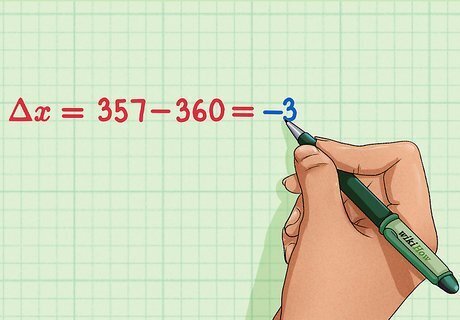
Subtract the actual value from the measured value. Since absolute error is always positive, take the absolute value of this difference, ignoring any negative signs. This will give you the absolute error. For example, since Δ x = 357 − 360 = − 3 {\displaystyle \Delta x=357-360=-3} \Delta x=357-360=-3, the absolute error of your measurement is 3 feet.
Using the Actual Value and Relative Error
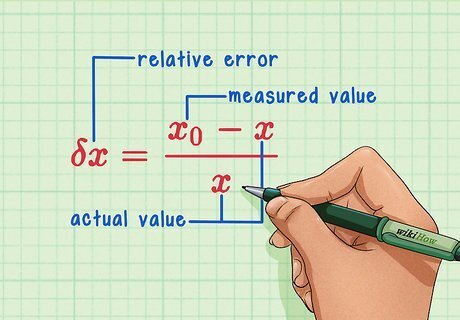
Set up the formula for relative error. The formula is δ x = x 0 − x x {\displaystyle \delta x={\frac {x_{0}-x}{x}}} \delta x={\frac {x_{{0}}-x}{x}}, where δ x {\displaystyle \delta x} \delta x equals the relative error (the ratio of the absolute error to the actual value), x 0 {\displaystyle x_{0}} x_{{0}} equals the measured value, and x {\displaystyle x} x equals the actual value.

Plug in the value for the relative error. This will likely be a decimal. Make sure you substitute it for δ x {\displaystyle \delta x} \delta x. For example, if you know that the relative error is .025, your formula will look like this: .025 = x 0 − x x {\displaystyle .025={\frac {x_{0}-x}{x}}} .025={\frac {x_{{0}}-x}{x}}.
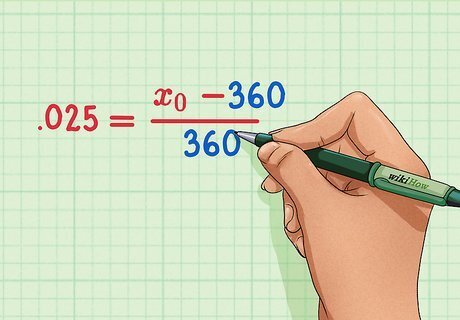
Plug in the value for the actual value. This information should be given to you. Make sure you substitute this value for x {\displaystyle x} x. For example, if you know that the actual value is 360 ft, your formula will look like this: .025 = x 0 − 360 360 {\displaystyle .025={\frac {x_{0}-360}{360}}} .025={\frac {x_{{0}}-360}{360}}.
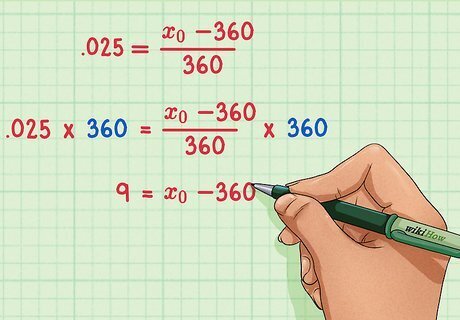
Multiply each side of the equation by the actual value. This will cancel out the fraction. For example: .025 = x 0 − 360 360 {\displaystyle .025={\frac {x_{0}-360}{360}}} .025={\frac {x_{{0}}-360}{360}} .025 × 360 = x 0 − 360 360 × 360 {\displaystyle .025\times 360={\frac {x_{0}-360}{360}}\times 360} .025\times 360={\frac {x_{{0}}-360}{360}}\times 360 9 = x 0 − 360 {\displaystyle 9=x_{0}-360} 9=x_{{0}}-360
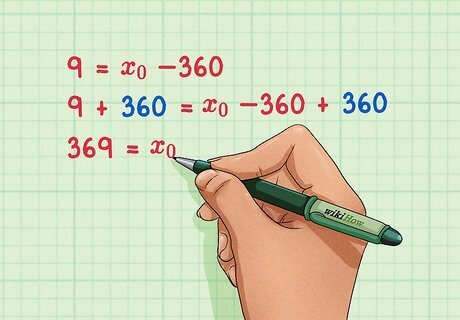
Add the actual value to each side of the equation. This will give you the value of x 0 {\displaystyle x_{0}} x_{{0}}, giving you the measured value. For example: 9 = x 0 − 360 {\displaystyle 9=x_{0}-360} 9=x_{{0}}-360 9 + 360 = x 0 − 360 + 360 {\displaystyle 9+360=x_{0}-360+360} 9+360=x_{{0}}-360+360 369 = x 0 {\displaystyle 369=x_{0}} 369=x_{{0}}
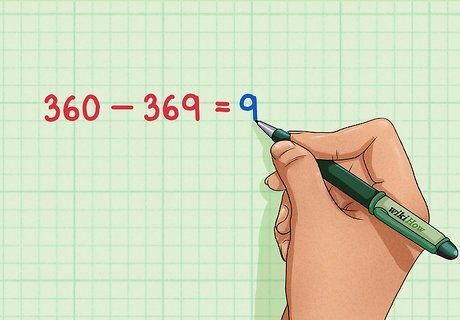
Subtract the actual value from the measured value. Since absolute error is always positive, take the absolute value of this difference, ignoring any negative signs. This will give you the absolute error. For example, if the measured value is 369 ft, and the actual value is 360 feet, you would subtract 369 − 360 = 9 {\displaystyle 369-360=9} 369-360=9. So, the absolute error is 9 feet.
Using the Maximum Possible Error
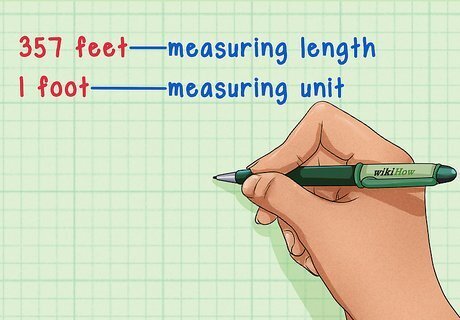
Determine the measuring unit. This is the “to the nearest” value. This might be explicitly stated (for example, “The building was measured to the nearest foot.”), but it doesn’t have to be. To determine the measuring unit, just look at what place value the measurement is rounded to. For example, if the measured length of a building is stated as 357 feet, you know that the building was measured to the nearest foot. So, the measuring unit is 1 foot.
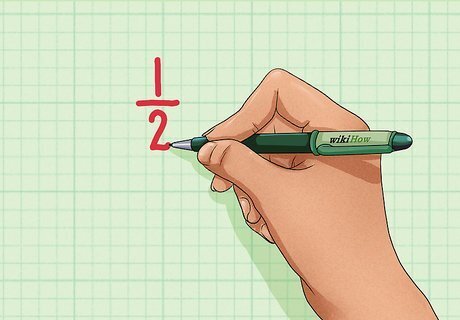
Determine the maximum possible error. The maximum possible error is 1 2 {\displaystyle {\frac {1}{2}}} {\frac {1}{2}} the unit of measure. You might see it listed as ± {\displaystyle \pm } \pm a number. For example, if the unit of measure is a foot, the maximum possible error is .5 ft. So you might see that the measurement of a building is 357 ± .5 f t {\displaystyle 357\pm .5ft} 357\pm .5ft. This means that the actual value of the building’s length could be .5 ft less or .5 ft more than the measured value. If it was any less/more, the measured value would have been 356 or 358 feet.
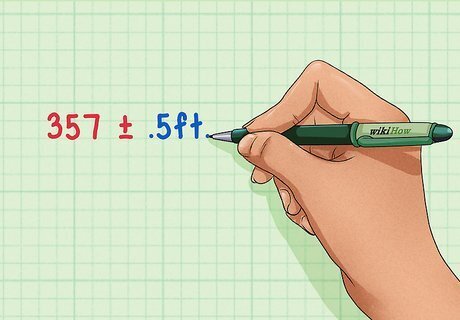
Use the maximum possible error as the absolute error. Since absolute error is always positive, take the absolute value of this difference, ignoring any negative signs. This will give you the absolute error. For example, if you find the measurement of a building to be 357 ± .5 f t {\displaystyle 357\pm .5ft} 357\pm .5ft, the absolute error is .5 ft.



















Comments
0 comment